Bulbs
Flower Basics
Flower Beds & Specialty Gardens
Flower Garden
Garden Furniture
Garden Gnomes
Garden Seeds
Garden Sheds
Garden Statues
Garden Tools & Supplies
Gardening Basics
Green & Organic
Groundcovers & Vines
Growing Annuals
Growing Basil
Growing Beans
Growing Berries
Growing Blueberries
Growing Cactus
Growing Corn
Growing Cotton
Growing Edibles
Growing Flowers
Growing Garlic
Growing Grapes
Growing Grass
Growing Herbs
Growing Jasmine
Growing Mint
Growing Mushrooms
Orchids
Growing Peanuts
Growing Perennials
Growing Plants
Growing Rosemary
Growing Roses
Growing Strawberries
Growing Sunflowers
Growing Thyme
Growing Tomatoes
Growing Tulips
Growing Vegetables
Herb Basics
Herb Garden
Indoor Growing
Landscaping Basics
Landscaping Patios
Landscaping Plants
Landscaping Shrubs
Landscaping Trees
Landscaping Walks & Pathways
Lawn Basics
Lawn Maintenance
Lawn Mowers
Lawn Ornaments
Lawn Planting
Lawn Tools
Outdoor Growing
Overall Landscape Planning
Pests, Weeds & Problems
Plant Basics
Rock Garden
Rose Garden
Shrubs
Soil
Specialty Gardens
Trees
Vegetable Garden
Yard Maintenance
How to Plant in Ceramic Pots
How to Plant in Ceramic Pots. Container gardening is a great way to add color and life to small areas. Patios and entryways are great places for ceramic pots of flowers or herbs because they don't require a lot of space. Gardeners with little time for maintenance can enjoy the ease of ceramic planters because they are easy to maintain and can be...

Container gardening is a great way to add color and life to small areas. Patios and entryways are great places for ceramic pots of flowers or herbs because they don't require a lot of space. Gardeners with little time for maintenance can enjoy the ease of ceramic planters because they are easy to maintain and can be moved around to instantly create a new look.
Things You'll Need
Ceramic pots
Commercial potting soil
Peat moss
Perlite
Plants
Water
Choose the pot size. Ceramic pots come in many sizes and looks. Choose a pot that will fit in the space you intend to put it. For example, if you plan to put a ceramic planter in an entryway, make sure it is not so large that it will impede the walkway. Also keep in mind that large pots hold more soil and thus more nutrients; small containers hold fewer nutrients and will need more frequent maintenance.
Create a good soil mixture. Ceramic pots have limited space for roots to grow and thrive, so it's important to use good soil. Make your own soil by mixing equal parts of commercial potting soil with peat moss or perlite. Native soil from your garden may have too much clay in it and provide poor drainage.
Prepare the pots. Clean the containers with water prior to filling them with soil. Next, place a small rock or a coffee filter over the drainage hole to help keep the soil from falling out. If you are planting a large pot, you can fill the bottom few inches with crushed aluminum cans or plastic milk jugs to reduce the weight and amount of soil needed.
Fill the pot with potting mix leaving about 3 inches of room between the top of the soil and the rim of the pot.
Plant your plants in the desired location of the ceramic pot just as you would plant them in the ground. Next, top off the roots with about an inch of soil mixture and water the plants. The surface level of the soil will drop about 1/2 inch when you water the planter.
Maintain your ceramic pots by watering them every second day, or when the top inch of soil is dry. Smaller pots will need more frequent watering as they don't hold as much soil. Use a hose or watering can to pour clean water into the planter, and stop when water begins to flow out of the drainage hole.
Tips & Warnings
Water your ceramic pots in the morning and twice on hot, sunny days.
Apply a 1-inch layer of mulch over the potting soil to help conserve moisture in warm climates.